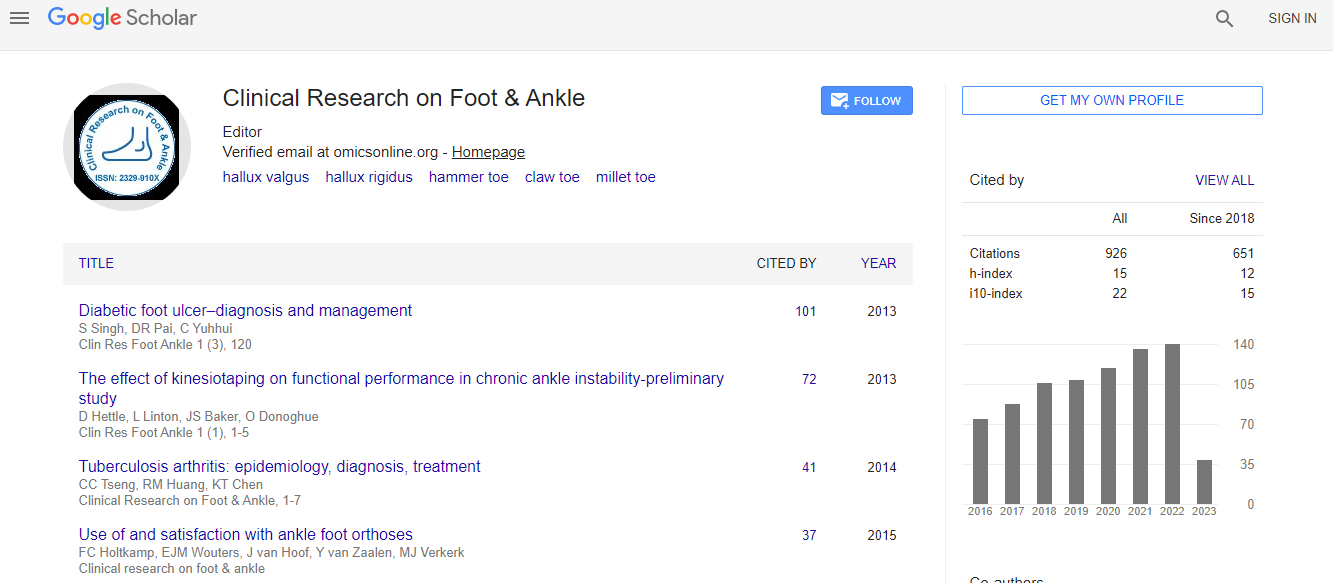Research Article
Use of and Satisfaction with Ankle Foot Orthoses
| Holtkamp FC1*, Wouters EJM1, van Hoof J1, van Zaalen Y1 and Verkerk MJ2,3 | ||
| 1Fontys University of Applied Sciences, Institute of Allied Health Professions, Dominee Theodor Fliednerstraat 2, 5631 BN Eindhoven, The Netherlands | ||
| 2Eindhoven University of Technology, Department of Industrial Engineering & Innovation Sciences, PO Box 513, 5600 MB Eindhoven, The Netherlands | ||
| 3Maastricht University, Department of Arts and Social Sciences, PO Box 616, 6200 MD Maastricht, The Netherlands | ||
| Corresponding Author : | Fred Holtkamp Fontys University of Applied Sciences Dominee Theodor Fliednerstraat 2 5631 BN Eindhoven, The Netherlands Tel: +31 651942732 Email: f.holtkamp@fontys.nl |
|
| Received April 14, 2015; Accepted May 28, 2015; Published May 30, 2015 | ||
| Citation: Holtkamp FC, Wouters EJM, van Hoof J, van Zaalen Y, Verkerk MJ (2015) Use of and Satisfaction with Ankle Foot Orthoses. Clin Res Foot Ankle 3:167. doi:10.4172/2329-910X.1000167 | ||
| Copyright: © 2015 Holtkamp FC, et al. This is an open-access article distributed under the terms of the Creative Commons Attribution License, which permits unrestricted use, distribution, and reproduction in any medium, provided the original author and source are credited. | ||
Related article at Pubmed Pubmed  Scholar Google Scholar Google |
||
Abstract
Objective: The aim of this study was to obtain insight in specific elements influencing the use, non-use, satisfaction, and dissatisfaction of ankle foot orthoses (AFOs) and the presence of underexposed problems with respect to AFOs.
Methods: A questionnaire was composed to obtain information from AFO users to investigate the variables associated with satisfaction and the relation between these variables. A specific feature of this study was the systematic analysis of the remarks made by the respondents about their AFO. Quantitative data analyses were used for analysing the satisfaction and qualitative analyses were used analysing the remarks of the respondents. A total of 211 users completed the questionnaire.
Results: Our survey showed that 1 out of 15 AFOs were not used at all. About three quarters of the AFO users were satisfied and about one quarter was dissatisfied. Females and users living alone reported relatively high levels of dissatisfaction, especially in the field of dimensions, comfort, weight, safety and effectiveness. Dissatisfaction with respect to off-the-shelf AFOs for the item durability was higher than that for custom-made AFOs. In the delivery and maintenance process the items ‘maintenance’, ‘professionalism’ and ‘delivery follow-up’ were judged to be unsatisfactory. A large number of comments were made by the respondents to improve the device or process, mainly by the satisfied AFO users. These comments show that even satisfied users experience many problems and that a lot of problems of AFO users are ‘underexposed’.
Conclusion: To improve user satisfaction, the user practice has to be identified as an important sub-process of the whole orthopaedic chain especially in the diagnosis and prescription, delivery tuning and maintenance, and evaluation phase.

 Spanish
Spanish  Chinese
Chinese  Russian
Russian  German
German  French
French  Japanese
Japanese  Portuguese
Portuguese  Hindi
Hindi 
